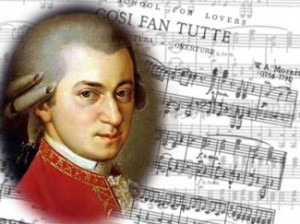
Credit: https://polyglottutor.files.wordpress.com/
In this work, two European slaves, Zaide and Gomatz, in the court of Sultan Soliman fall in love and convince their overseer to set them free. Captured again, the slaves appear to Soliman’s compassion and gain their freedom. They are to be returned to Europe to demonstrate that “also Asia can bring forth souls of virtue.”
Only one aria has come into the standard repertoire: Act I’s Ruhe sanft, mein holdes Leben (Rest in peace, my dear), sung by Gomatz to Zaide.
Mozart: Zaide, K. 344, Act I: Aria: Ruhe sanft, mein holdes Leben (Kiri Te Kanawa, Gomatz; London Symphony Orchestra; Colin Davis, cond.)
How do you fill out a shell of an opera? Many performances add an overture of Mozart’s Symphony No. 32, K. 318, which was written at the same time; Nikolas Harnoncourt’s recording uses the earlier Symphony No. 26. To fill out the missing last act, material is taken from the incidental music Mozart wrote between 1773 and 1780 for Thamos, King of Egypt. As Zaide is not a true opera, sung entirely throughout, but is a singspiel, an opera with spoken dialogue, modern performers also have to recreate all that missing dialogue.
Why hasn’t this two-thirds opera entered the repertoire? It is by the exalted Mozart, after all. One reason might be that the librettist didn’t produce a book of much literary quality but the larger reason might be that Mozart had returned to the same subject with a different opera: The Abduction from the Seraglio, completed two years later. What we do see in Zaide is the beginning of Mozart’s dramatic language. Here, his arias still start conventionally, for the most part, but when he ventures into reforming declaimed speech and accompanies it with dramatic music that we start to see his innovation. We can certainly hear how this kind of writing influenced Beethoven in Fidelio. In Zaide, we see the composer at work and in Abduction, we get the fruits of his labors.



